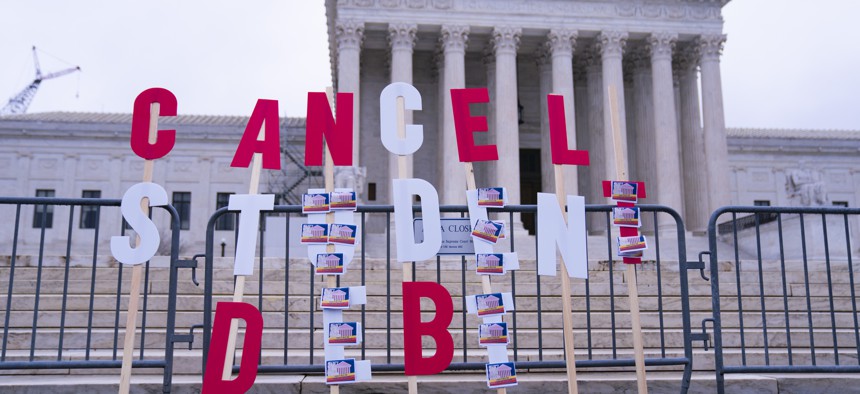Can student debt relief attract workers to state and local government jobs?

The Washington Post via Getty Images
More than 46% of state and local employees reported being “extremely or very worried” about paying back their student loans. A new report suggests addressing that concern could entice more people into the public sector.
As state and local governments continue to struggle to hire and retain workers, one solution to the problem could be to help reduce or cancel student debt, according to a recent report by the MissionSquare Research Institute, a nonprofit that studies government workforce issues.
In a survey conducted in 2022 of more than 1,000 state and local government employees, the institute found that 46% were “extremely or very worried” about paying back their student loans.
Based on that, the institute estimated the average amount of debt held by those who work in 15 of the most difficult to fill state and local positions. Those with associate degrees in the professions evaluated owed an average of $12,785; those with bachelor's degrees owed $23,052; masters degree holders owed $37,598; and those with doctoral degrees owed $70,404.
The positions were determined by a survey of human resources managers, who collectively said that public safety jobs were among the most difficult to fill. Specifically, 78% of HR managers reported that they had a hard time filling positions in policing, and 77% mentioned jobs involving corrections or jails. Those with associate degrees in criminal justice or corrections owed an average of $16,075.
Health care jobs were the next hardest positions to fill. Seventy-one percent of HR managers said they were having trouble hiring mental health and substance abuse counselors. The report found that those with bachelor's degrees in psychology owed an average of $24,004, while those with a master's degree owed $50,708.
Because of the tens of thousands owed in student debt, those considering working in the public sector have to think about “whether a salary at a particular job will be sufficient to meet their needs,” according to the report, which was coauthored by the Center for Public Health Systems at the University of Minnesota.
Many state and local governments can’t offer the same high salaries as the public sector, though. As a result, the study concluded, “student debt may be one obstacle preventing individuals from exploring and pursuing careers in state and local government.”
On top of having difficulty recruiting workers in some professions, the survey of 249 HR managers found that about 45% said they are seeing more people quit in 2023 than in 2022.
The findings back up a separate study from last year that found 69% of state and local workers were feeling negative about their jobs. Forty-nine percent said they had felt stressed, and 47% said they were burned out. Two-thirds reported considering changing jobs to get better pay or benefits. And about one-third said they wanted a job with greater satisfaction or meaning—the same percentage said they wanted greater work-life balance.
Admittedly, the ability of state and local governments to help with student debt is limited following last year’s decision by the U.S. Supreme Court to strike down President Joe Biden’s program to forgive student debt. Part of his plan was to reduce the amount borrowers had to pay each month based on their income. Borrowers’ debts would have also been forgiven after 10 years of repayments instead of 20 years.
Biden has pledged to find another solution, but in the meantime public officials could consider utilizing the Public Service Loan Forgiveness program. The MissionSquare report said it “may be a way to incentivize potential employees to work and remain in the state or local government workforce.”
Under the program, government and nonprofit workers have their student debt forgiven after making 120 payments. But the program has been criticized for being confusing, leading to many applicants being denied.
State and local governments can rectify that problem by providing clear guidance to potential and current employees on how to apply for the program. Managers should also ask current workers in the program to share information about it.
Going a step further, state and local governments, the report said, could also include information about the Public Service Loan Forgiveness program in their recruitment materials and in new-hire packets.
States and localities could also urge the federal government to forgive higher amounts of debt for workers in positions that are hard to fill.
Kery Murakami is a senior reporter for Route Fifty, covering Congress and federal policy. He can be reached at kmurakami@govexec.com. Follow @Kery_Murakami
NEXT STORY: Meet the newest member of your team: the chief AI officer






